University Name NSB 231: Analysis of Mr. Bright's Nursing Assessments
VerifiedAdded on 2022/09/26
|6
|1408
|35
Report
AI Summary
This report details the nursing assessments conducted on Mr. Bright, a patient who underwent angioplasty. It emphasizes the importance of pain assessment, infection risk evaluation, and monitoring of vital signs in post-operative care. The report highlights the use of the WHO pain scale and the significance of early infection detection. It also identifies aspects of care that were not performed, such as nutritional assessments, patient education, and self-image perception assessments. The ISBAR format is used to provide a structured verbal handover to the doctor, focusing on Mr. Bright's chest pain and other symptoms. The report underscores the nurse's role in comprehensive patient care, including monitoring for complications, and providing patient and family education. The assessment also emphasizes the importance of psychological support and adaptation to the new state of the body after surgery.
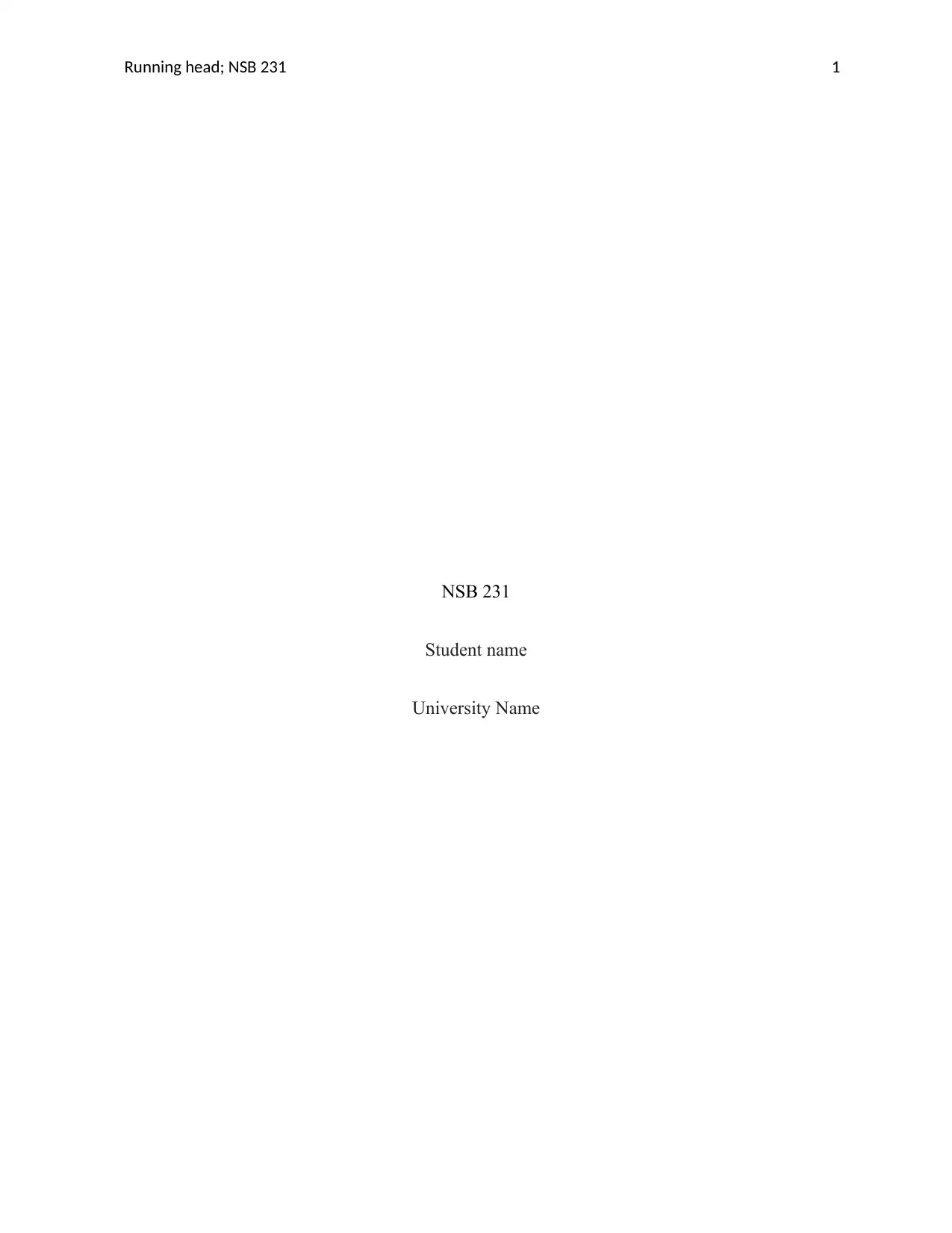
Running head; NSB 231 1
NSB 231
Student name
University Name
NSB 231
Student name
University Name
Paraphrase This Document
Need a fresh take? Get an instant paraphrase of this document with our AI Paraphraser
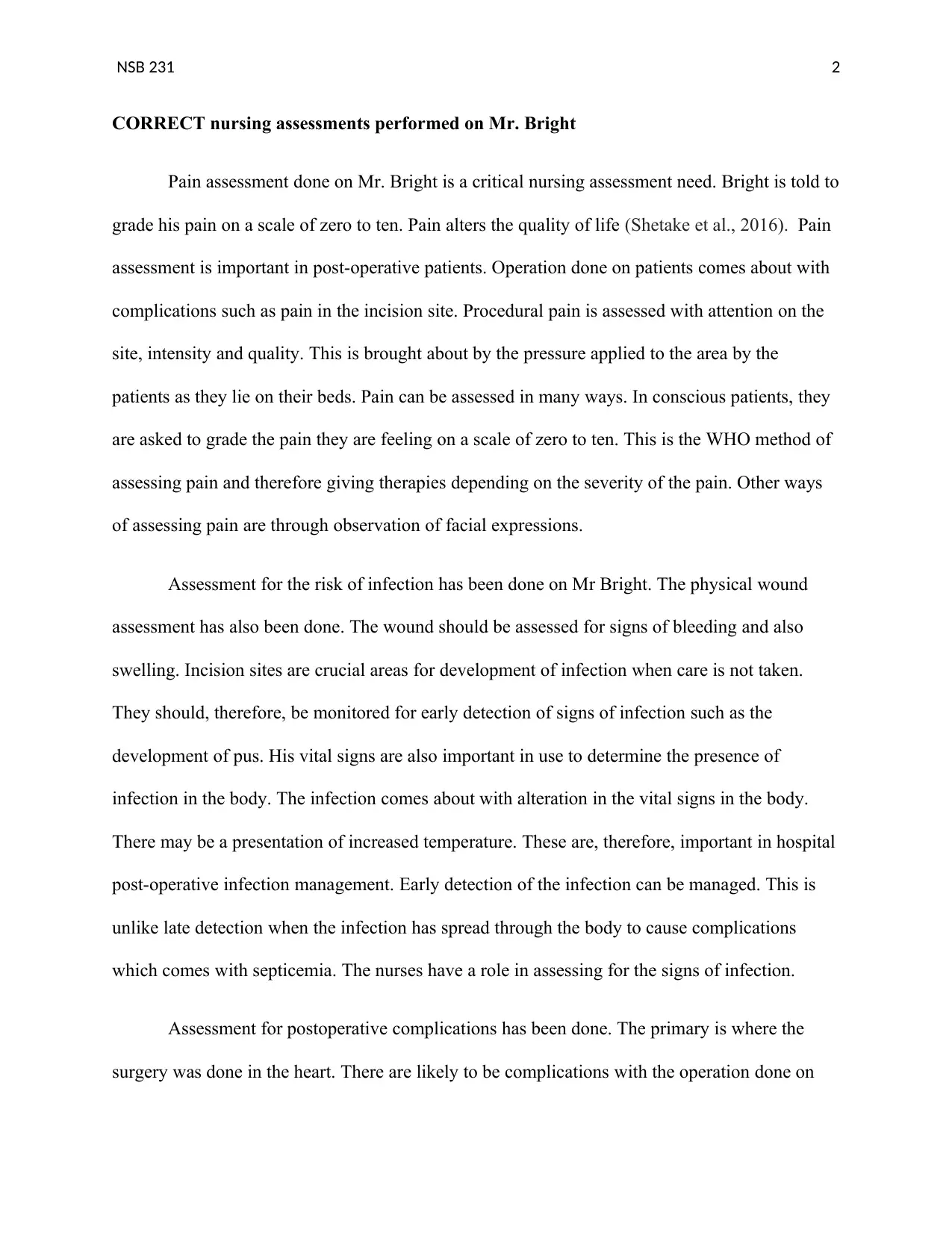
NSB 231 2
CORRECT nursing assessments performed on Mr. Bright
Pain assessment done on Mr. Bright is a critical nursing assessment need. Bright is told to
grade his pain on a scale of zero to ten. Pain alters the quality of life (Shetake et al., 2016). Pain
assessment is important in post-operative patients. Operation done on patients comes about with
complications such as pain in the incision site. Procedural pain is assessed with attention on the
site, intensity and quality. This is brought about by the pressure applied to the area by the
patients as they lie on their beds. Pain can be assessed in many ways. In conscious patients, they
are asked to grade the pain they are feeling on a scale of zero to ten. This is the WHO method of
assessing pain and therefore giving therapies depending on the severity of the pain. Other ways
of assessing pain are through observation of facial expressions.
Assessment for the risk of infection has been done on Mr Bright. The physical wound
assessment has also been done. The wound should be assessed for signs of bleeding and also
swelling. Incision sites are crucial areas for development of infection when care is not taken.
They should, therefore, be monitored for early detection of signs of infection such as the
development of pus. His vital signs are also important in use to determine the presence of
infection in the body. The infection comes about with alteration in the vital signs in the body.
There may be a presentation of increased temperature. These are, therefore, important in hospital
post-operative infection management. Early detection of the infection can be managed. This is
unlike late detection when the infection has spread through the body to cause complications
which comes with septicemia. The nurses have a role in assessing for the signs of infection.
Assessment for postoperative complications has been done. The primary is where the
surgery was done in the heart. There are likely to be complications with the operation done on
CORRECT nursing assessments performed on Mr. Bright
Pain assessment done on Mr. Bright is a critical nursing assessment need. Bright is told to
grade his pain on a scale of zero to ten. Pain alters the quality of life (Shetake et al., 2016). Pain
assessment is important in post-operative patients. Operation done on patients comes about with
complications such as pain in the incision site. Procedural pain is assessed with attention on the
site, intensity and quality. This is brought about by the pressure applied to the area by the
patients as they lie on their beds. Pain can be assessed in many ways. In conscious patients, they
are asked to grade the pain they are feeling on a scale of zero to ten. This is the WHO method of
assessing pain and therefore giving therapies depending on the severity of the pain. Other ways
of assessing pain are through observation of facial expressions.
Assessment for the risk of infection has been done on Mr Bright. The physical wound
assessment has also been done. The wound should be assessed for signs of bleeding and also
swelling. Incision sites are crucial areas for development of infection when care is not taken.
They should, therefore, be monitored for early detection of signs of infection such as the
development of pus. His vital signs are also important in use to determine the presence of
infection in the body. The infection comes about with alteration in the vital signs in the body.
There may be a presentation of increased temperature. These are, therefore, important in hospital
post-operative infection management. Early detection of the infection can be managed. This is
unlike late detection when the infection has spread through the body to cause complications
which comes with septicemia. The nurses have a role in assessing for the signs of infection.
Assessment for postoperative complications has been done. The primary is where the
surgery was done in the heart. There are likely to be complications with the operation done on
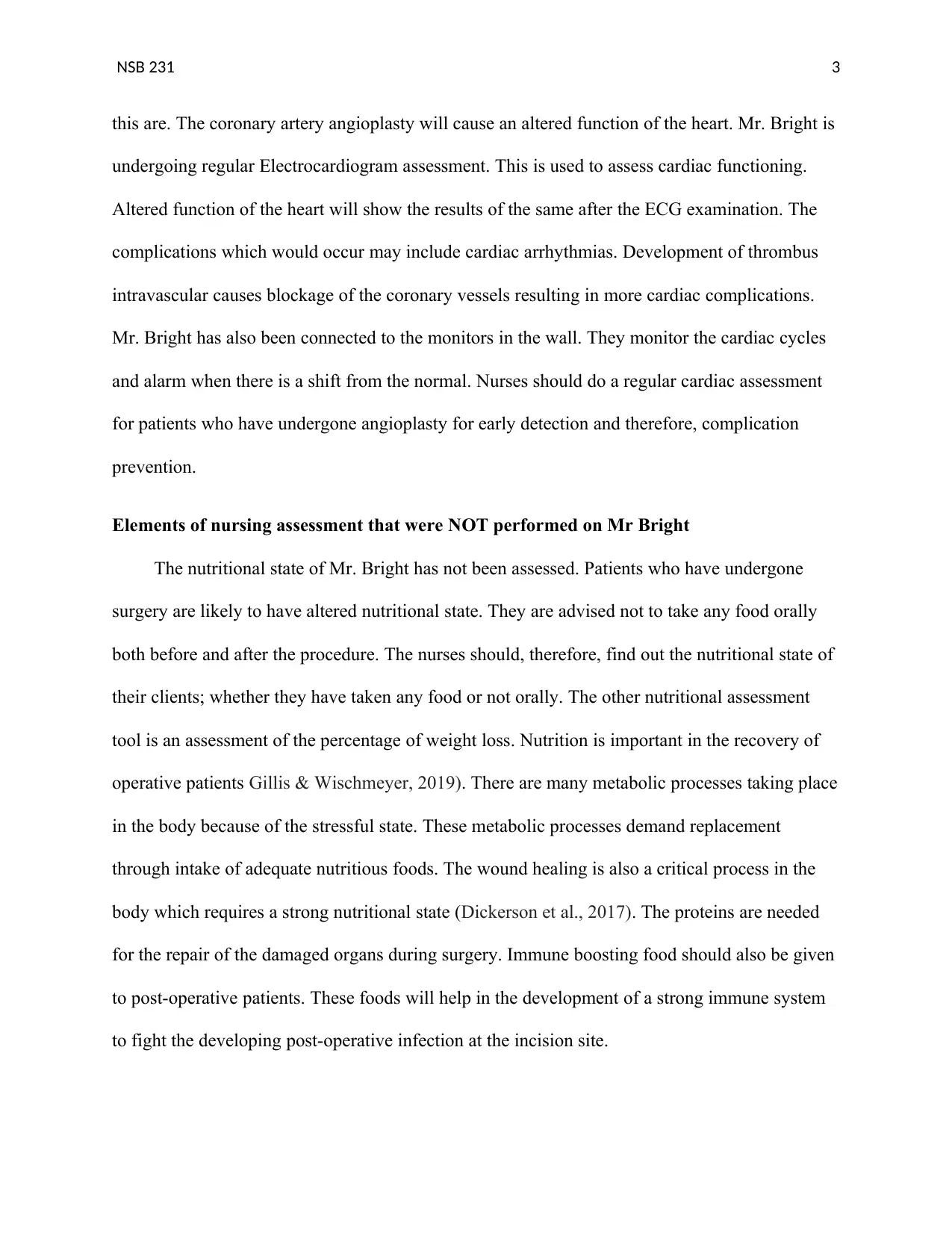
NSB 231 3
this are. The coronary artery angioplasty will cause an altered function of the heart. Mr. Bright is
undergoing regular Electrocardiogram assessment. This is used to assess cardiac functioning.
Altered function of the heart will show the results of the same after the ECG examination. The
complications which would occur may include cardiac arrhythmias. Development of thrombus
intravascular causes blockage of the coronary vessels resulting in more cardiac complications.
Mr. Bright has also been connected to the monitors in the wall. They monitor the cardiac cycles
and alarm when there is a shift from the normal. Nurses should do a regular cardiac assessment
for patients who have undergone angioplasty for early detection and therefore, complication
prevention.
Elements of nursing assessment that were NOT performed on Mr Bright
The nutritional state of Mr. Bright has not been assessed. Patients who have undergone
surgery are likely to have altered nutritional state. They are advised not to take any food orally
both before and after the procedure. The nurses should, therefore, find out the nutritional state of
their clients; whether they have taken any food or not orally. The other nutritional assessment
tool is an assessment of the percentage of weight loss. Nutrition is important in the recovery of
operative patients Gillis & Wischmeyer, 2019). There are many metabolic processes taking place
in the body because of the stressful state. These metabolic processes demand replacement
through intake of adequate nutritious foods. The wound healing is also a critical process in the
body which requires a strong nutritional state (Dickerson et al., 2017). The proteins are needed
for the repair of the damaged organs during surgery. Immune boosting food should also be given
to post-operative patients. These foods will help in the development of a strong immune system
to fight the developing post-operative infection at the incision site.
this are. The coronary artery angioplasty will cause an altered function of the heart. Mr. Bright is
undergoing regular Electrocardiogram assessment. This is used to assess cardiac functioning.
Altered function of the heart will show the results of the same after the ECG examination. The
complications which would occur may include cardiac arrhythmias. Development of thrombus
intravascular causes blockage of the coronary vessels resulting in more cardiac complications.
Mr. Bright has also been connected to the monitors in the wall. They monitor the cardiac cycles
and alarm when there is a shift from the normal. Nurses should do a regular cardiac assessment
for patients who have undergone angioplasty for early detection and therefore, complication
prevention.
Elements of nursing assessment that were NOT performed on Mr Bright
The nutritional state of Mr. Bright has not been assessed. Patients who have undergone
surgery are likely to have altered nutritional state. They are advised not to take any food orally
both before and after the procedure. The nurses should, therefore, find out the nutritional state of
their clients; whether they have taken any food or not orally. The other nutritional assessment
tool is an assessment of the percentage of weight loss. Nutrition is important in the recovery of
operative patients Gillis & Wischmeyer, 2019). There are many metabolic processes taking place
in the body because of the stressful state. These metabolic processes demand replacement
through intake of adequate nutritious foods. The wound healing is also a critical process in the
body which requires a strong nutritional state (Dickerson et al., 2017). The proteins are needed
for the repair of the damaged organs during surgery. Immune boosting food should also be given
to post-operative patients. These foods will help in the development of a strong immune system
to fight the developing post-operative infection at the incision site.
⊘ This is a preview!⊘
Do you want full access?
Subscribe today to unlock all pages.

Trusted by 1+ million students worldwide
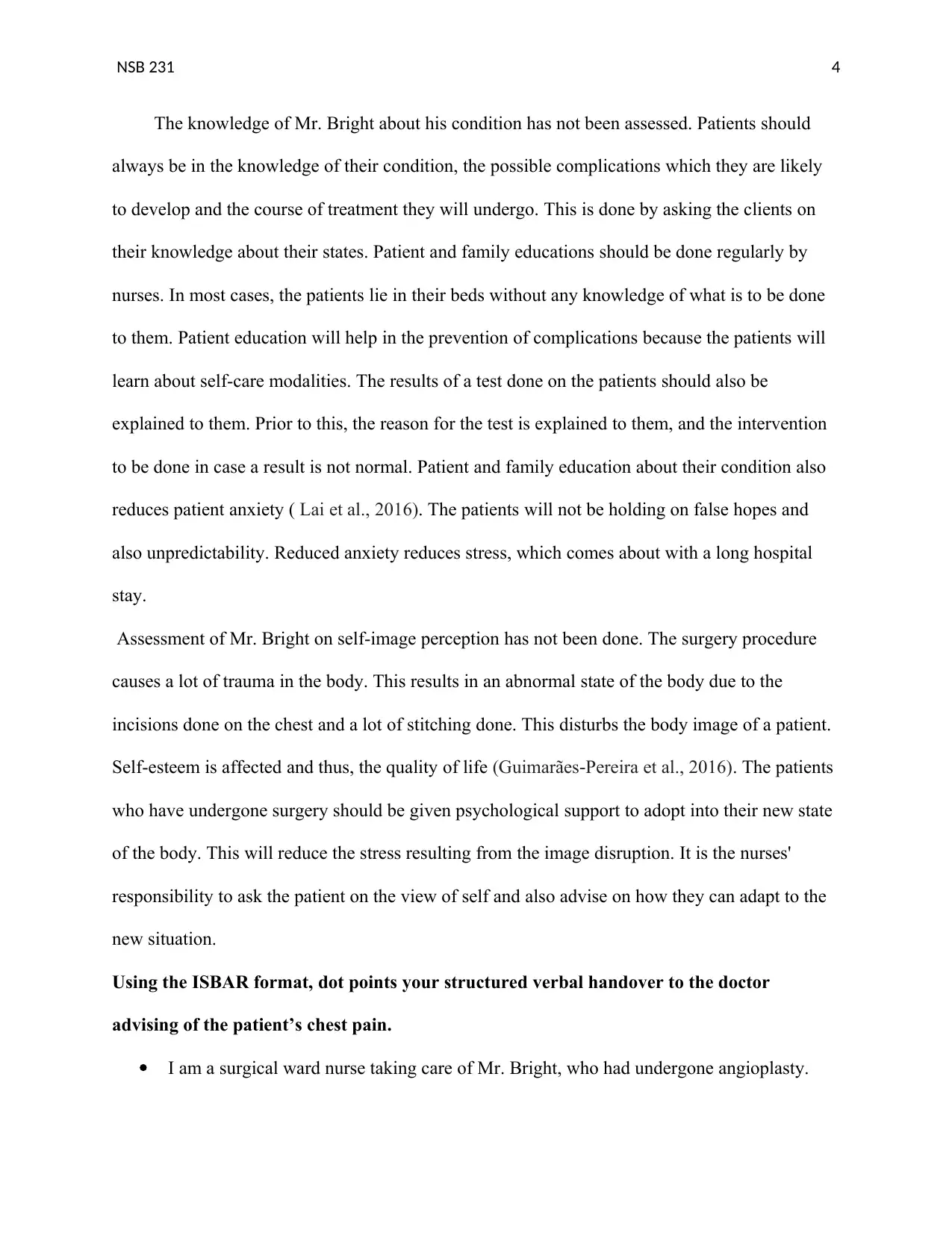
NSB 231 4
The knowledge of Mr. Bright about his condition has not been assessed. Patients should
always be in the knowledge of their condition, the possible complications which they are likely
to develop and the course of treatment they will undergo. This is done by asking the clients on
their knowledge about their states. Patient and family educations should be done regularly by
nurses. In most cases, the patients lie in their beds without any knowledge of what is to be done
to them. Patient education will help in the prevention of complications because the patients will
learn about self-care modalities. The results of a test done on the patients should also be
explained to them. Prior to this, the reason for the test is explained to them, and the intervention
to be done in case a result is not normal. Patient and family education about their condition also
reduces patient anxiety ( Lai et al., 2016). The patients will not be holding on false hopes and
also unpredictability. Reduced anxiety reduces stress, which comes about with a long hospital
stay.
Assessment of Mr. Bright on self-image perception has not been done. The surgery procedure
causes a lot of trauma in the body. This results in an abnormal state of the body due to the
incisions done on the chest and a lot of stitching done. This disturbs the body image of a patient.
Self-esteem is affected and thus, the quality of life (Guimarães Pereira et al., 2016)‐ . The patients
who have undergone surgery should be given psychological support to adopt into their new state
of the body. This will reduce the stress resulting from the image disruption. It is the nurses'
responsibility to ask the patient on the view of self and also advise on how they can adapt to the
new situation.
Using the ISBAR format, dot points your structured verbal handover to the doctor
advising of the patient’s chest pain.
I am a surgical ward nurse taking care of Mr. Bright, who had undergone angioplasty.
The knowledge of Mr. Bright about his condition has not been assessed. Patients should
always be in the knowledge of their condition, the possible complications which they are likely
to develop and the course of treatment they will undergo. This is done by asking the clients on
their knowledge about their states. Patient and family educations should be done regularly by
nurses. In most cases, the patients lie in their beds without any knowledge of what is to be done
to them. Patient education will help in the prevention of complications because the patients will
learn about self-care modalities. The results of a test done on the patients should also be
explained to them. Prior to this, the reason for the test is explained to them, and the intervention
to be done in case a result is not normal. Patient and family education about their condition also
reduces patient anxiety ( Lai et al., 2016). The patients will not be holding on false hopes and
also unpredictability. Reduced anxiety reduces stress, which comes about with a long hospital
stay.
Assessment of Mr. Bright on self-image perception has not been done. The surgery procedure
causes a lot of trauma in the body. This results in an abnormal state of the body due to the
incisions done on the chest and a lot of stitching done. This disturbs the body image of a patient.
Self-esteem is affected and thus, the quality of life (Guimarães Pereira et al., 2016)‐ . The patients
who have undergone surgery should be given psychological support to adopt into their new state
of the body. This will reduce the stress resulting from the image disruption. It is the nurses'
responsibility to ask the patient on the view of self and also advise on how they can adapt to the
new situation.
Using the ISBAR format, dot points your structured verbal handover to the doctor
advising of the patient’s chest pain.
I am a surgical ward nurse taking care of Mr. Bright, who had undergone angioplasty.
Paraphrase This Document
Need a fresh take? Get an instant paraphrase of this document with our AI Paraphraser

NSB 231 5
Mr. Bright started complaining of chest pain, pressure on the wound in the groin and
struggling in breathing
His vital signs are; Blood pressure 130/80,
He is an admission from the theatre. He had undergone angioplasty of the right coronary
artery.
We are monitoring his vital signs and blood sugar levels. We are thinking of changing his
position in bed
\
References
Mr. Bright started complaining of chest pain, pressure on the wound in the groin and
struggling in breathing
His vital signs are; Blood pressure 130/80,
He is an admission from the theatre. He had undergone angioplasty of the right coronary
artery.
We are monitoring his vital signs and blood sugar levels. We are thinking of changing his
position in bed
\
References
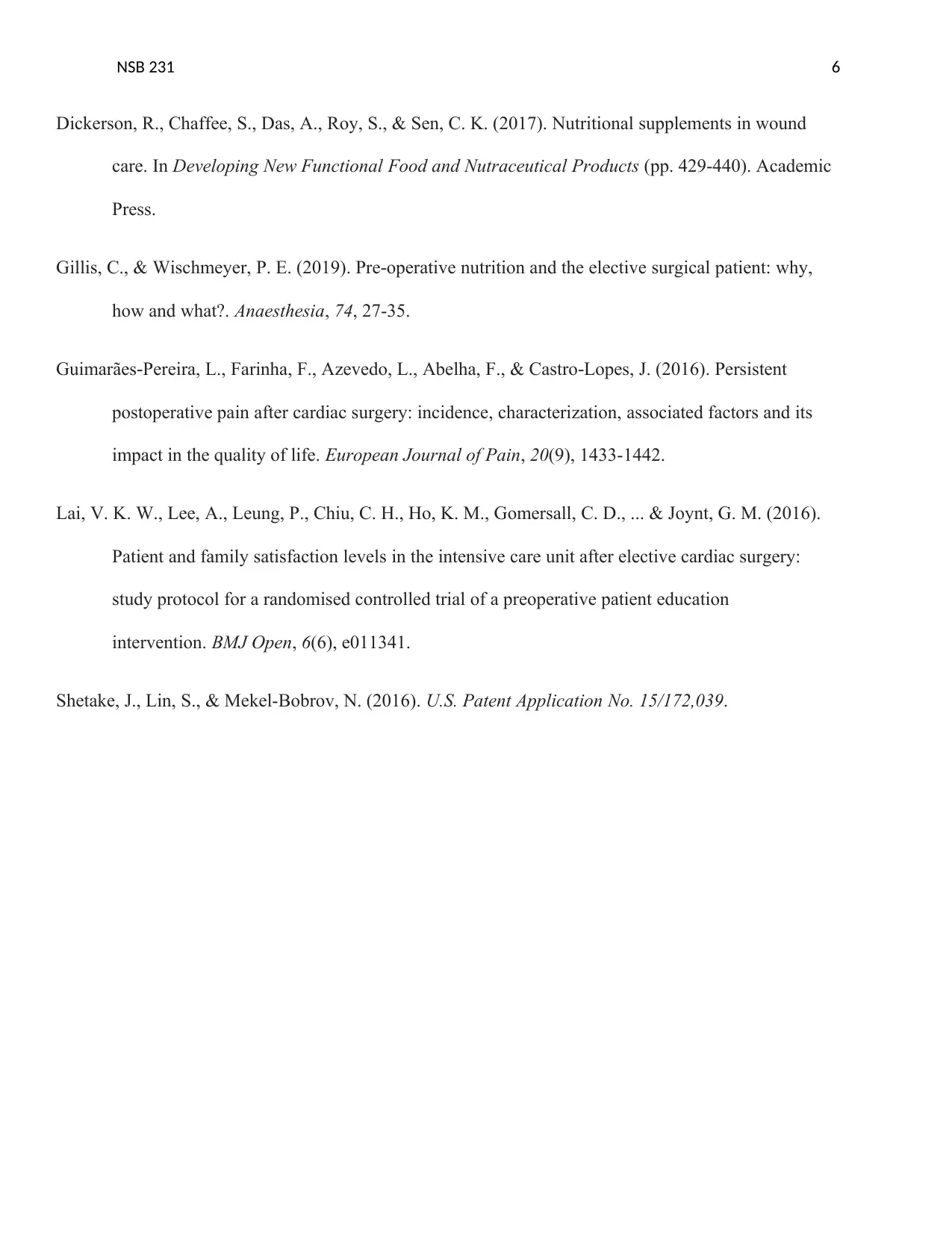
NSB 231 6
Dickerson, R., Chaffee, S., Das, A., Roy, S., & Sen, C. K. (2017). Nutritional supplements in wound
care. In Developing New Functional Food and Nutraceutical Products (pp. 429-440). Academic
Press.
Gillis, C., & Wischmeyer, P. E. (2019). Pre operative nutrition and the elective surgical patient: why,‐
how and what?. Anaesthesia, 74, 27-35.
Guimarães Pereira, L., Farinha, F., Azevedo, L., Abelha, F., & Castro Lopes, J. (2016). Persistent‐ ‐
postoperative pain after cardiac surgery: incidence, characterization, associated factors and its
impact in the quality of life. European Journal of Pain, 20(9), 1433-1442.
Lai, V. K. W., Lee, A., Leung, P., Chiu, C. H., Ho, K. M., Gomersall, C. D., ... & Joynt, G. M. (2016).
Patient and family satisfaction levels in the intensive care unit after elective cardiac surgery:
study protocol for a randomised controlled trial of a preoperative patient education
intervention. BMJ Open, 6(6), e011341.
Shetake, J., Lin, S., & Mekel-Bobrov, N. (2016). U.S. Patent Application No. 15/172,039.
Dickerson, R., Chaffee, S., Das, A., Roy, S., & Sen, C. K. (2017). Nutritional supplements in wound
care. In Developing New Functional Food and Nutraceutical Products (pp. 429-440). Academic
Press.
Gillis, C., & Wischmeyer, P. E. (2019). Pre operative nutrition and the elective surgical patient: why,‐
how and what?. Anaesthesia, 74, 27-35.
Guimarães Pereira, L., Farinha, F., Azevedo, L., Abelha, F., & Castro Lopes, J. (2016). Persistent‐ ‐
postoperative pain after cardiac surgery: incidence, characterization, associated factors and its
impact in the quality of life. European Journal of Pain, 20(9), 1433-1442.
Lai, V. K. W., Lee, A., Leung, P., Chiu, C. H., Ho, K. M., Gomersall, C. D., ... & Joynt, G. M. (2016).
Patient and family satisfaction levels in the intensive care unit after elective cardiac surgery:
study protocol for a randomised controlled trial of a preoperative patient education
intervention. BMJ Open, 6(6), e011341.
Shetake, J., Lin, S., & Mekel-Bobrov, N. (2016). U.S. Patent Application No. 15/172,039.
⊘ This is a preview!⊘
Do you want full access?
Subscribe today to unlock all pages.

Trusted by 1+ million students worldwide
1 out of 6
Related Documents
Your All-in-One AI-Powered Toolkit for Academic Success.
+13062052269
info@desklib.com
Available 24*7 on WhatsApp / Email
![[object Object]](/_next/static/media/star-bottom.7253800d.svg)
Unlock your academic potential
Copyright © 2020–2025 A2Z Services. All Rights Reserved. Developed and managed by ZUCOL.





